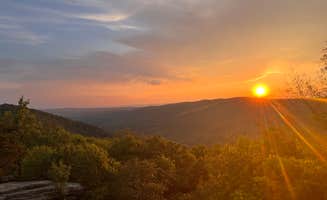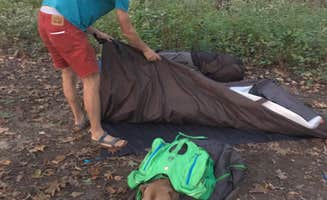Dispersed camping near Sharpsburg, Maryland occurs primarily in neighboring states, with the closest options in West Virginia and Virginia. The region sits at the junction of three states, with the Potomac and Shenandoah Rivers creating natural boundaries. Fall and spring offer the most moderate temperatures for camping, with summer humidity often exceeding 80% and winter temperatures frequently dropping below freezing, particularly at higher elevations.
What to do
Fishing opportunities: Edwards Run Wildlife Management Area provides basic fishing access for beginners and families. According to Frank G., "Fun place to teach the kids the basics of fishing, but the campground area leaves a little to be desired." The small waterways contain primarily panfish and small bass.
Hiking excursions: Compton Gap in Shenandoah National Park connects to extensive trail networks. Les R. notes, "Hiked in from the Dickey ridge trail parking lot." The area offers moderate terrain with occasional steep sections requiring proper footwear.
Wildlife observation: Early mornings provide optimal wildlife viewing at primitive campsites. The spring and fall migrations bring diverse bird species through the region, while deer and small mammals can be spotted year-round.
What campers like
Budget-friendly options: Free primitive camping makes Edwards Run Wildlife Management Area attractive for cost-conscious outdoor enthusiasts. Jim M. reports, "As I pulled in there was a kiosk with a sign that said $10 camping fee but no info on how or where to pay... However no one came by."
Level tent sites: Finding flat ground for setting up camp isn't difficult in designated areas. Jim M. mentioned, "the site was level and grassy. Nice camp site." This makes for comfortable sleeping conditions without extensive site preparation.
Solitude: Despite proximity to major cities, dispersed camping options remain relatively uncrowded. Most sites have substantial natural buffers between camping areas, particularly for those willing to walk short distances from parking areas.
What you should know
Limited facilities: Expect minimal or no amenities at these primitive camping locations. At Compton Gap Backcountry camping, Les R. confirms it's functional but basic: "If you're a through hiker, it'll get the job done though."
Insect activity: Bug populations vary seasonally with higher concentrations during warmer months. Les R. warns about Compton Gap: "Lots of bugs" and describes conditions as "Buggy and damp."
Permit requirements: Some locations require advance permits for overnight stays. While Edwards Run has unclear payment procedures, Shenandoah backcountry requires formal permits obtained before camping.
Site selection: Better camping spots often require short hikes from parking areas. Frank G. advises about Edwards Run: "There's a lot by the road that looks like it's where they want you to camp but there are better sites on in. Just gotta hike to em."
Tips for camping with families
Start with roadside options: For families with young children, choose more accessible sites. Edwards Run offers roadside camping that Frank G. describes as the area where "they want you to camp," making it easier to transport gear with children.
Bring complete supplies: No services means bringing all necessities. Pack additional water than you think necessary, especially during summer when children may need more hydration.
Plan for weather variability: Mountain elevation creates significant temperature fluctuations between day and night. Pack appropriate clothing layers for children who may be more sensitive to temperature changes.
Tips from RVers
Size limitations: Most dispersed camping areas near Sharpsburg have minimal development and cannot accommodate large RVs. Standard vehicles can access Edwards Run, but larger rigs will find turning around difficult on narrow access roads.
No hookups available: Bring sufficient water reserves and plan for no electrical connections. Self-contained units work best, as toilet facilities range from portable units to none at all.
Road conditions: Access roads to primitive camping areas often feature gravel surfaces with occasional ruts or erosion. Recent rainfall can significantly impact drivability, particularly for vehicles with lower clearance.



